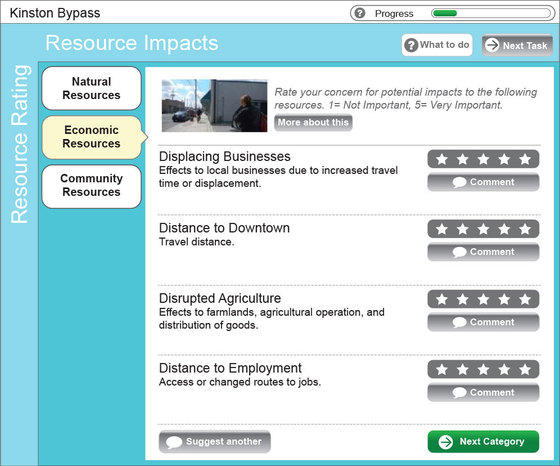Innovation of the Month:
Virtual Public Involvement
Virtual public involvement tools increase participation and transparency in transportation planning and project development, saving money and agency staff time while reducing potential project delays by identifying issues early.
All-in-one tools that combine crowdsourcing, mapping, and survey functions are a one-stop-shop for informing the public about a project and engaging individuals through polls and surveys. The tools increase public participation by removing barriers to involvement and make it easy for agencies to manage public involvement on a single platform.
The North Carolina Department of Transportation (NCDOT) generated 19 times more response than in past efforts when it added an all-in-one tool to the public involvement process while developing its 2018–2027 State Transportation Improvement Program. The tool garnered more detailed feedback from users and increased engagement among 26- to 40-year-old stakeholders, typically an underrepresented group in NCDOT public involvement efforts.
Digital tools, including tablets and other handheld devices, add value to in-person information-sharing events and allow every participant to be heard through such tools as live polling. Agencies also equip teams with digital tools that enable them to take project plans into communities to solicit live feedback from residents.
The Minnesota Department of Transportation (MnDOT) targeted limited English proficiency (LEP) populations while updating the Statewide Multimodal Transportation Plan by using tablet-based surveys in multiple languages. The surveys allowed MnDOT staff to visit LEP communities and obtain stakeholder feedback to incorporate into the plan.
Visit FHWA’s virtual public involvement web page for deployment resources such as webinars and factsheets.
For information and technical assistance, contact Scott Allen, Jody McCullough, or Harold Peaks of the Federal Highway Administration Office of Planning, Environment, and Realty.
 All-in-one tool for public involvement. Credit: North Carolina Department of Transportation
New York Develops Permitting Procedures for Highway-Stream Crossings
New York agencies are collaborating on a programmatic agreement and process for assessing culverts and bridges for aquatic organism passage (AOP) at highway-stream crossings. The New York State Department of Environmental Conservation and U.S. Army Corps of Engineers require that replaced, rehabilitated, and new stream crossings provide AOP, but New York does not have a standard method to assess crossings or barriers, which makes the permitting process inconsistent and time-consuming for the New York State Department of Transportation and regulators. The agencies are developing permitting procedures based on the North Atlantic Aquatic Connectivity Collaborative method to bring more predictability and transparency to culvert assessments and reduce permitting timeframes. For information, contact Mike Ruth of the FHWA Office of Planning, Environment, and Realty.
Systemic Safety Analysis Workshop Now Available
The systemic safety approach involves implementing improvements across a roadway network based on the identification of high-risk features correlated with specific severe crash types. FHWA now offers a workshop that leads practitioners through the Systemic Safety Project Selection Tool, focusing on the benefits of the approach and how to apply the methodology to identify improvement projects through interactive exercises and case studies. Read more in the FHWA Safety Compass newsletter. To schedule a workshop, contact Karen Scurry of the FHWA Office of Safety.
|